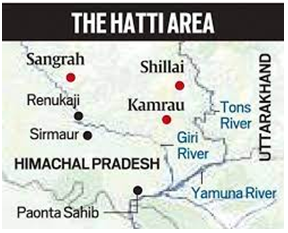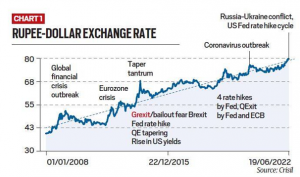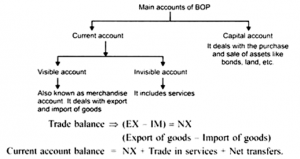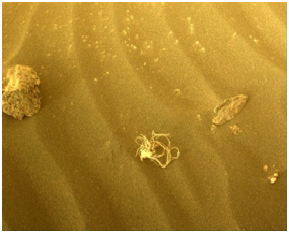DAILY CURRENT AFFAIRS (JULY 20, 2022)
THE INDIAN POLITY AND GOVERNANCE
1.THE DEMAND FOR ‘TRIBAL’ STATUS FOR HIMACHAL’S TRANS-GIRI AND ITS HATTI COMMUNITY
THE CONTEXT: The Centre is reported to be considering granting “tribal” status to the Trans-Giri region of Himachal Pradesh’s Sirmaur district. The reported proposal, if followed through, would mark a movement away from the government’s earlier position on the matter.
THE EXPLANATION:
The demand to declare Trans-Giri a tribal area is old — and is tied up with the demand for Scheduled Tribe (ST) status for the Hatti community which lives in the area.
The community and the land
- The Hattis are a close-knit community who take their name from their traditional occupation of selling home-
 grown crops, vegetables, meat, and wool at small-town markets known as ‘haats’. Hatti men traditionally don a distinctive white headgear on ceremonial occasions.
grown crops, vegetables, meat, and wool at small-town markets known as ‘haats’. Hatti men traditionally don a distinctive white headgear on ceremonial occasions. - According to sources, the Hattis live in 154 panchayat areas, and that member of the community numbered 2.5 lakh in the 2011 Census. The present population of the Hattis is estimated at around 3 lakh.
- The Hattis are governed by a traditional council called ‘khumbli’ which, like the ‘khaps’ of Haryana, decide community matters.
Demand for tribal status
- The list of STs in Himachal Pradesh includes Gaddis, Gujjars, Kinnaras (Kinnauras), Lahaulas, Pangwalas, and some other smaller tribes. The bulk of the tribal population lives in remote, high altitude areas in the districts of Lahaul, Spiti, Kinnaur, and Chamba. The tribal population of the state was 3.92 lakh (about 6% of the total) in 2011.
- The Hattis have been demanding ST status since 1967, when tribal status was accorded to people living in JaunsarBawar in Uttarakhand, which shares a border with Sirmaur district. Over the years, various ‘mahakhumblis’ passed resolutions pressing the demand.
- Since getting the benefit of reservations, the JaunsarBawar area has produced a sizable number of civil servants. Due to topographical disadvantages, however, the Hattis living in the Kamrau, Sangrah, and Shilliai areas of Himachal Pradesh have lagged behind in both education and employment.
VALUE ADDITION:
What are the benefits for being accorded as Scheduled Tribe?
- The Indian Constitution ensures certain protection for communities deemed as having Scheduled Tribe (ST) status. However, which groups should be accorded that status has been contentious. Getting ST status means that members of the group have access to highly desired tangible benefits such as political representation, reserved seats in schools, and government jobs.
Who has the power to declare a community/Tribes as Scheduled Tribe?
- The Indian Constitution only states that STs are specified by the President after consultation with the Governor; it does not specify specific criteria.
- According to the Ministry of Tribal Affairs, the criterion—while not spelled out in legislation—“is well established,” and includes indication of “primitive” traits, distinctive culture, geographical isolation, “shyness of connect” with the community at large, and “backwardness.” These general standards were established following the definitions of the 1931 Census, the reports of the First Backward Classes Commission 1955, Kalelkar Advisory Committee, and Revision of SC/ST lists by the Lokur Committee. However, more than a half-century later, these broad criteria leave a lot of discretion.
THE INTERNATIONAL RELATIONS
2.A MAJOR INDIA-AFRICA CONCLAVE IS TAKING PLACE IN NEW DELHI — WHY IS IT IMPORTANT?
THE CONTEXT: Recently,the High-level diplomats from several African countries met Vice President of India for Investment summit in New Delhi.
THE EXPLANATION:
The summit
- Forty high-level ministers from 17 countries, including Cameroon, Burkina Faso, Eswatini, Republic of the Congo, Ethiopia, Gabon, Equatorial Guinea, Ghana, Niger, Malawi, Mauritius, Sudan, Namibia, Nigeria and Sierra Leone, are participating in the two-day summit.
- The CII-EXIM Bank Conclave on India-Africa Growth Partnership was launched in 2005 with the support of India’s Ministry of External Affairs and Ministry of Commerce & Industry to encourage the development of private investment from India in African countries.
- This is the 17th edition of the conclave. Over the years, it has “emerged as one of the largest congregations of senior ministers, policy makers and business leaders from Africa and India, cutting across sectors”, and “played a pivotal role in encouraging Indian companies to establish and grow their footprint in Africa”.
This year’s conclave focuses on infrastructure development and trade finance, education and training, agriculture and food processing, consultancy services, and healthcare in addition to other areas where Indian companies have steadily increased their presence over the years in Africa.
The significance
- Trade between the African subcontinent and India increased from $7.2 billion in 2001 to $59.9 billion in 2017, making India the continent’s fourth-largest national trading partner, according to Exim Bank and the African Export-Import Bank (Afriexim Bank). Trade with India accounted for more than 4 per cent of total African trade in 2017.
- Data from the Ministry of Commerce and Industry show bilateral trade between India and the 48 countries of sub-Saharan Africa was valued at $46.82 billion in 2020-21, down from $55.70 billion in 2019-20. India has a negative trade balance with sub-Saharan Africa, according to the Ministry .
Duty Free Tariff Preference (DFTP) is a unilateral non-reciprocal preferential tariff scheme provided by the Government of India for the least developed countries (LDCs). The scheme was officially introduced on 13 August 2008.
- In a statement issued on Africa Day on May 25, the Ministry of External Affairs said that 38 African nations have benefited from India’s Duty-Free Tariff Preference (DFTP) scheme which provides duty free access to 98.2 per cent of India’s total tariff lines.
- Lines of Credit (LoCs) worth $12.26 billion have so far been extended to African countries, making them the second-largest recipient of India’s concessional loans, the MEA said.
Key countries
- Mauritius is the first and only African country so far to have a CECPA (Comprehensive Economic Cooperation and Partnership Agreement) with India, an agreement that aims at building trade ties between the two countries.
- Political stability and rapid economic recovery post Covid-19 have made resource-rich Namibia in southern Africa attractive for foreign investment, the conclave’s website says. The country has rich deposits of uranium, diamonds, copper, phosphates and other minerals.
- Over the years, Indian enterprises have invested in energy, healthcare, and agriculture sectors, as well as the business of diamond cutting and polishing, in Namibia. Analysts expect these sectors to grow over the next few years.
THE SOCIAL ISSUES AND SOCIAL JUSTICE
3.WHY DO PEOPLE GIVE UP THEIR INDIAN CITIZENSHIP, AND WHERE DO THEY GO?
THE CONTEXT: Answering to an unstarred question in Lok Sabha (Monsoon session 2022) the Ministry of Home Affairs stated that over 1.6 lakh Indians relinquished their Indian citizenship in 2021.
THE EXPLANATION:
- The numbers marked a sharp increase in comparison to the 85,256 people who gave up their Indian citizenship in the Covid-hit year of 2020, and a somewhat smaller increase over the 1.44 lakh who surrendered their passports in 2019.
- According to government data, the largest numbers of Indians who relinquished Indian citizenship in 2021
 went to the United States (78,284), followed by Australia (23,533), Canada (21,597), and the United Kingdom (14,637).
went to the United States (78,284), followed by Australia (23,533), Canada (21,597), and the United Kingdom (14,637). - Smaller numbers of those who gave up their Indian citizenship chose Italy (5,986), New Zealand (2,643), Singapore (2,516), Germany (2,381), the Netherlands (2,187), Sweden (1,841), and Spain (1,595).
- India does not allow dual citizenship, and taking up the citizenship of another country automatically results in the cancellation of Indian citizenship.
Why do people renounce citizenship?
- The reasons vary widely from country to country, and among socio-economic and ethnic groups. In general, around the world, people leave their countries for better jobs and living conditions, and some are pushed out by climate change or unfavourable political situations at home.
- As the Indian diaspora around the world has increased in numbers, with newer generations holding passports of other countries, some older Indians are choosing to leave to be with family settled overseas. In some high-profile cases — such as that of jeweller Mehul Choksi — people who leave India may be fleeing the law or fear of legal action for alleged crimes.
- A 2020 report by the Global Wealth Migration Review showed that high net worth individuals around the world who renounce citizenship acquired at birth may do so for reasons of rising crime rates or the lack of business opportunities at home. “It can also be a sign of bad things to come as (they) are often the first people to leave — they have the means to leave unlike middle class citizens,” the report said.
- Among the other reasons why people make the decision to migrate to other countries and to eventually acquire citizenship listed by the Global Wealth Migration Review were: safety of women and children, lifestyle factors like climate and pollution, financial concerns including taxes, better healthcare for families and educational opportunities for children, and to escape oppressive governments.
Why do people choose certain specific countries when they leave India?
- Although the Global Wealth Migration Review focuses on global data, some of its listed factors may also be applicable to Indians specifically. In general, countries where Indians have been migrating for long or where people have family or friends would be more automatic choices, as would be considerations such as easier paperwork and more welcoming social and ethnic environments.
- The report highlighted the global popularity of Australia as a country that has been witnessing high inflow numbers. Factors specific to Australia that made it a popular destination included its points-based immigration system that favoured the wealthy and high-earning professionals like doctors, lawyers, engineers, and accountants, the report said.
- The report said Australia may have been a top choice, in part because of English being the spoken language, in addition to its healthcare system, which unlike the US was not as complex or expensive for older individuals of high net worth.
- The report listed Singapore as the emerging “top wealth management centre” in Asia, marking its potential for attracting higher numbers of these individuals.
THE ECONOMIC DEVELOPMENTS
4.WHAT RS 80 TO A DOLLAR MEANS?
THE CONTEXT: The Indian rupee breached the psychologically significant exchange rate level of 80 to a US dollar in early trade on Tuesday. It recovered some ground to close at 79.90.
THE EXPLANATION:
Since the war in Ukraine began, and crude oil prices started going up, the rupee has steadily lost value against the dollar. There are growing concerns about how a weaker rupee affects the broader economy and what challenges it presents to policymakers, especially since India is already grappling with high inflation and weak growth.
What is the rupee exchange rate?
- The rupee’s exchange rate vis-à-vis the dollar is essentially the number of rupees one needs to buy $1. This is an important metric to buy not just US goods but also other goods and services (say crude oil) trade in which happens in US dollars.
- Broadly speaking, when the rupee depreciates, importing goods and service becomes costlier. But if one is trying to export goods and services to other countries, especially to the United States, India’s products become more competitive because depreciation makes these products cheaper for foreign buyers.

How bad is it for the rupee?
- According to Crisil data, shows the rupee’s exchange rate against the dollar. The dotted line shows the long-term trend of depreciation. If the rupee depreciates at a rate faster than the long-term average, it goes above the dotted line, and vice versa. In the last couple of years, the rupee has been more resilient than the long-term trend. The current fall has brought about a correction.
- Another thing to note is that, at least as of now, the rupee is still more resilient (that is, it has remained relatively strong against the dollar) than it was in some of the previous crises such as the Global Financial Crisis of 2008 and the Taper Tantrum of 2013.
- Moreover, the US dollar is just one of the currencies Indians need to trade. If one looks at a whole basket of currencies, then data suggests the rupee has become stronger (or appreciated against that basket). In other words, while the US dollar has become stronger against all other major currencies including the rupee, the rupee, in turn, has become stronger than many other currencies such as the euro.
Why are the rupee-dollar exchange rate and forex reserves falling?
- Balance of Payment (BoP): The BoP is essentially a ledger of all monetary transactions between Indians and foreigners. Here it is shown in US dollar terms. If a transaction leads to dollars coming into India, it is shown with a positive sign; if a transaction means dollars leaving India, it is shown with a minus sign.
- The BoP has two broad subheads (also called “accounts”) — current and capital — to slot different types of transactions. The current account is further divided into the trade account (for export and import of goods) and the invisibles account (for export and import of services). So if an Indian buys an American car, dollars will flow out of BoP, and it will be accounted for in the trade account within the current account.
- If an American invests in Indian stock markets, dollars will come into the BoP table and it will be accounted for under FPI within the capital account. The important thing about the BoP is that it always “balances”.

What will be the effect on the economy?
- Since a large proportion of India’s imports are dollar-denominated, these imports will get costlier. A good example is the crude oil import bill. Costlier imports, in turn, will widen the trade deficit as well as the current account deficit, which, in turn, will put pressure on the exchange rate.
- On the exports front, however, Economists noted that it is less straightforward. For one, in bilateral trade, the rupee has become stronger than many currencies. In exports that happen via the dollar, “Also, the noted since, the rupee is not the only currency weakening against the dollar, the net effect will depend on how much has the other currency lost to the dollar”. “If the other currency has lost more than the rupee, the net effect could be negative.”
THE SCIENCE AND TECHNOLOGY
5.WHAT IS THAT NOODLE TANGLE ON MARS?
THE CONTEXT: Recently, NASA’s Perseverance Rover has beamed back from Mars a picture of a “strange tangle” — an object that looks like a partially uncoiled ball of string or, in the imagination of some, a rather long and thin noodle.
THE EXPLANATION:
What’s this picture?
- The picture shows the object — string or noodle — between two Martian rocks, a smaller, flat one to the right and a larger one to the left. Another, zoomed-out, view shows the scale of the object, lying directly beneath the
 Perseverance Rover close to its wheels, with other rocks and a bit of the Martian landscape also in the frame.
Perseverance Rover close to its wheels, with other rocks and a bit of the Martian landscape also in the frame. - The image was taken on July 12 by the Perseverance Rover’s Front Left Hazard Avoidance Camera A. As the rover moves, its six HazCams detect hazards like large rocks, trenches, or sand dunes.
Why is the picture odd?
For obvious reasons — unless you don’t have difficulty imagining the existence of Martians who both love and litter their spaghetti. NASA has said nothing officially about what the object might be, or how it got in the frame of Perseverance’s HazCam.
And why it probably isn’t…
- The object is likely to be space junk from NASA’s Mars mission. Such extra-terrestrial trash has been spotted on the red planet earlier too.
- The un-Martian objects imaged on Mars so far include the parachute used by Perseverance during its landing in February last year (2021).
- In June, the rover captured a shiny object on the Martian ground, which Perseverance said on Twitter was “something unexpected” — before identifying it as “part of a thermal blanket — a material used to control temperatures” during its descent to the surface last year.
VALUE ADDITION:
NASA’S PERSEVERANCE
- NASA’s Perseverance rover is exploring the Jezero Crater on Mars and attempting to collect its first rock samples.
- It was launched in 2020 aboard a United Launch Alliance Atlas V.
Why is this mission significant?
- It carried a unique instrument, MOXIE or Mars Oxygen ISRU Experiment: which for the first time manufactured molecular oxygen on Mars using carbon dioxide from the carbon-dioxide-rich atmosphere (ISRU means In Situ Resource Utilization: or the use of local resources to meet human needs or requirements of the spacecraft).
- It carried Ingenuity, the first ever helicopter to fly on Mars.
- It is the planned first step to bring back rock samples from Mars for analysis in sophisticated laboratories on Earth: with the goal of looking for biosignatures: or signatures of present or past life.
These are some of the key mission objectives:
- Look for signs of ancient microbial life.
- Collect Martian rock and dust samples for later return to Earth.
- Deliver an experimental helicopter.
- Study the climate and geology of Mars.
- Demonstrate technology for future Mars missions.
THE PRELIMS PERSPECTIVE
6.ONE WORD A DAY – RCTS
THE CONTEXT: Recently, the Economist and Nobel laureate Michael R Kremer has said that for a diverse country like India randomised controlled trials (RCTs) must be carried out at multiple sites for better analysis and to see differences across states.
THE EXPLANATION:
What is RCT (Randomised Controlled Trials)?
- It is a research design for experimental studies, which economists Michael R Kremer, Abhijit Banerjee and Esther Duflo used in their research.
- They went on to win the 2019 Nobel Prize winner in Economics.
- They had made use of RCT for their research on poverty.
- It is usually undertaken to study the effects of a new entrant in an environment.
- According to Kramer, the idea involved in RCT is to experiment at multiple sites and then do a better analysis and see the differences across the sites.
- Simply put, RCTs involve dividing a population into smaller groups, in order to comparatively see the outcomes of an external stimulus.
What did the noble citation say of the trio’s work?
“The research conducted by this year’s laureates has considerably improved our ability to fight global poverty…Their new experiment-based approach has transformed development economics.”
What is an example of randomised controlled trials?
Example:
Aim of a study: To understand whether a free grains distribution scheme helped improve the nutrition levels among people living in a district.
Objective: To understand what the overall impact of introducing something new could be.
Steps:
- Researchers will first create two groups within the population, and then put people into those groups randomly.
- One group (called the control group) does not receive the grains or the external stimulus, while the other group (treatment group) does.
- After a designated period of time, details of how both the groups are doing would be collected.
What has been one successful example of RCTs application?
- RCTs application showed neither providing more textbooks nor free school meals improved learning among students.
- Instead, in schools in Mumbai and Vadodara, the biggest problem was that teaching was not sufficiently adapted to the students’ needs.
- The Nobel laureates had billed RCTs as a method to focus on more day-to-day answers to problems of poverty and deprivation, such as the delivery of basic amenities.
Why are RTCs criticised?
- Critics say the method cannot be used in all cases, while others argue it is fundamentally flawed.
- Angus Deaton, the winner of the Economics Nobel in 2015, had said “randomisation does not equalise two groups”, and warned against over-reliance on RCTs to frame policies.
- Like him, many believe that two or more groups carved out from a singular population living in an area may not be totally random.
- There may be more women in one group, or one group may have more people having some kind of distinctiveness that affects the result.
- As a result, the outcomes may not give an accurate view, and the very use of a scientific experiment tool in social sciences was questioned.
- Further, RCTs also cannot be used to study something after it has happened, they need to be planned beforehand.
- And, while RCTs show results for a particular population in an area, it may not be proof that the same results will be achieved elsewhere, especially if the sample size is not big or the trial
However, many agree that for a limited purpose RCTs have helped to tweak systems and improve outcomes.
THE PRELIMS PRACTICE QUESTIONS
QUESTION OF THE DAY
Q.Consider the following statements in the context of Randomised Controlled Trials (RCT):
- It is usually undertaken to study the effects of a new entrant in an environment.
- Abhijit Banerjee and Esther Duflo used in their research and went on to win the 2019 Nobel Prize winner in Medicine.
Which of the above statements is/are correct?
a) 1 only
b) 2 only
c) Both 1 and 2
d) Neither 1 nor 2
ANSWER FOR 19TH JULY 2022
ANSWER: D
EXPLANATION:
- Statement 1 is incorrect.National awards such as Bharat Ratna, Padma Vibhushan, Padma Bhushan and Padma Shri do not amount to titles within the meaning of Article 18(1) of the Constitution and thus are not to be used as prefixes or suffixes to the name of the recipient in any manner.
- Article 18(1) abolishes all titles. It prohibits the State to confer titles on anybody whether a citizen or a non-citizen. Military and academic distinctions are, however, exempted from the prohibition. Thus, a university can give title or honor on a man of merit.
- Statement 2 is incorrect. Padma Awards were instituted in 1954 to be awarded to citizens of India in recognition of their distinguished contribution in various spheres of activity.
- The government suspended the practice of granting the Padma awards for two years in 1977. It was again suspended during mid-1992 when 2 PILs were filed in the High Courts of India
- They are given in three categories: Padma Vibhushan (for exceptional and distinguished service), Padma Bhushan (distinguished service of higher-order) and Padma Shri (distinguished service).
- Statement 3 is incorrect. A maximum of 3 people can be awarded the Bharat Ratna. The total number of Padma awards to be conferred each year is limited to 120. But the count excludes posthumous awards and any non-resident Indian or Overseas Citizen of India or foreign-based winners.